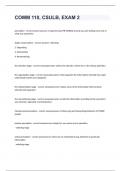NUR 231 Exam 2- Activity, Exercise &
Mobility, Urinary Elimination, Wound
Assessment, Care, & Irrigations,
Medication Administration Q&A
Begin with nursing process ✅1) assessment
2) diagnose
3) plan
4) implement
5) evaluate
Interventions for the immobilized ✅maintain proper body alignment, turn at least every
2 hours, ROM, CPM machine, positioning aides, special mattresses, elastic
stockings/sequential compression device
Why do we want to get pts. Up ASAP? ✅to reduce or eliminate the effects of
immobility such as orthostatic hypotension and thrombus formation mobilize the pt. As
soon as the physical condition allows, even if this only involves dangling at the bedside
of moving to a chair
Orthostatic hypotension ✅form of low blood pressure that happens when you stand up
from sitting or lying down
Thrombus formation (thrombosis) ✅formation of a blood clot inside a blood vessel,
obstructing the flow of blood through the circulatory system
Nurse safety ✅before lifting assess the weight to be lifted, determine the assistance
needed, use safe pt. Handling equipment when the pt. Is unable to assist in transfer,
use manual lifting only as a last resort, use proper body mechanics if lifting is required
Body mechanics ✅the coordinated effort of the musculoskeletal and nervous systems
to maintain balance, posture, and body alignment during lifting, bending, moving, and
performing ADL's
Purpose of body mechanics ✅facilitate body movement so that a person can carry out
physical activity without using excessive muscle energy or injury
Tips for ambulation ✅stand on pts. Stronger side, if pt. Is using a cane stand on the
weaker side and position cane on stronger side, walk behind pt. When using a walker
, Controlled fall ✅catch the pt. In a manner that allows them to safely slide down your
legs while holding them
*CH. 45 URINARY ELIMINATION* ✅
Organs of urinary elimination ✅kidneys, ureters, bladder, urethra
Factors influencing urination ✅disease conditions, medications and medical
procedures, socioeconomic factors (need for privacy), psychological factors (anxiety,
stress, privacy), fluid balance (nocturia, plyuria, oliguria, anuria, diuresis, fever)
Nocturia ✅condition in which you wake up during the night because you have to
urinate, condition becomes more common as people age and occurs both in men and
women, sometimes for different reasons
Polyuria ✅production of abnormally large volumes of dilute urine
Oliguria ✅production of abnormally small amount of urine (400 ml per day or less)
Anuria ✅failure to produce urine, no output
Diuresis ✅increases frequency of urinating
Fever ✅urine output decreases; more concentrated
Average urine output ✅2100-1500 ml/day (should produce 30 ml/hour)
**need to contact physician if 30 ml or less/day
Disease conditions affecting urination ✅prerenal classification, renal classification,
postrenal classificaton, diabetes mellitus, benign prostatic hyperplasia, cognitive
impairments (ex: alzheimer's), conditions that make it difficult to reach and use toilet
facilities, end-stage renal disease
Indications for dialysis ✅renal failure that can no longer be controlled by conservative
management, worsening of uremic syndrome associated with end-stage renal disease
(ESRD), severe electrolyte and/or fluid abnormalities that cannot be controlled by
simpler measures
Dialysis ✅process for removing waste and excess water from the blood and is used
primarily as an artificial replacement for lost kidney function in people with kidney
failure; takes one of two forms—peritoneal dialysis or hemodialysis. Patients can use
both dialysis modalities for short or long term, but these treatments require specialized
equipment and nurses with specialized education





